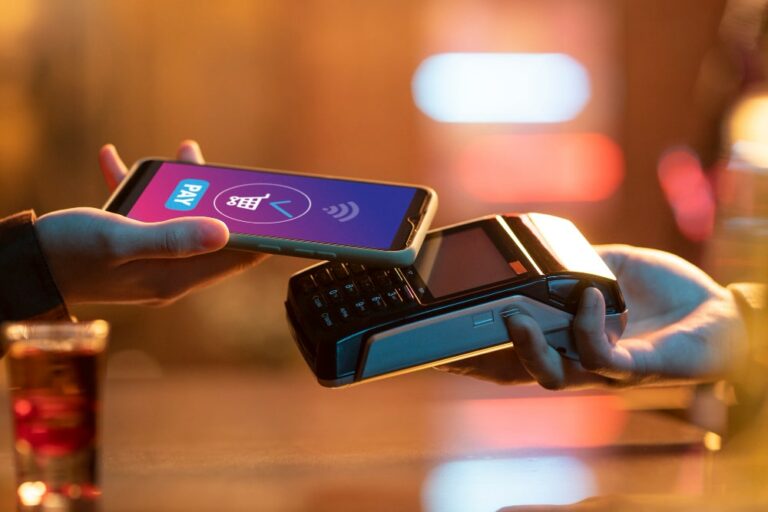In the ever-evolving landscape of finance and commerce, the traditional clink of coins and rustle of banknotes are gradually giving way to a silent yet powerful revolution—QR code payments. The ubiquity of these pixelated squares, initially designed to streamline inventory management, has transcended far beyond their original purpose. Today, they stand as the vanguards of a cashless future, where financial transactions are as simple as a scan and a tap.
QR code payments represent a paradigm shift in the way we conduct transactions. These enigmatic patterns, resembling digital hieroglyphs, have become a ubiquitous sight in our daily lives, adorning everything from product packaging to restaurant menus. With a simple scan from a smartphone, consumers can settle bills, make purchases, and transfer funds with unparalleled ease and efficiency. It’s a transformation that not only streamlines the payment process but also holds the potential to democratize access to financial services, bridging the divide between the banked and unbanked.
This article embarks on a journey to dissect the phenomenon of QR code payments, illuminating how these unassuming patterns are silently ushering in a cashless revolution. We will delve into their rise, explore the ecosystem that powers them, examine their myriad benefits, and confront the challenges they pose. Join us as we unravel the intricate web of QR code payments and witness the gradual displacement of cash by the digital convenience of the future.
The Rise of QR Code Payments:
In the not-so-distant past, QR codes were often associated with marketing campaigns or a quick way to access a website’s URL. Fast forward to today, and these unassuming black-and-white squares have evolved into powerful tools that are fundamentally altering the way we make payments. The rise of QR code payments can be likened to a quiet yet relentless wave, sweeping across the global financial landscape.
Origins and Adoption:
QR code payments, like many technological innovations, had humble beginnings. They were first created in Japan in the 1990s for tracking automotive parts during manufacturing. However, their potential for contactless transactions wasn’t fully realized until the proliferation of smartphones with built-in cameras.
China played a pivotal role in popularizing QR code payments, particularly through mobile apps like Alipay and WeChat Pay. In a country where cash was once king, these apps swiftly gained traction, allowing users to scan QR codes for payments at stores, restaurants, and even street vendors. This transformative shift in consumer behavior demonstrated the convenience and speed of QR code transactions.
The trend soon spread to other parts of Asia, Europe, and the Americas, as businesses recognized the benefits of accepting QR code payments. It wasn’t just limited to physical establishments; online retailers, too, began integrating QR codes into their checkout processes, offering a seamless payment option for e-commerce shoppers.
The Simplicity and Convenience:
What makes QR code payments so appealing is their sheer simplicity. To make a payment, all one needs is a smartphone equipped with a camera and a QR code scanning app. Customers scan the merchant’s QR code, enter the payment amount, and confirm the transaction—quick, intuitive, and hassle-free.
Merchants, on the other hand, find QR code payments equally enticing. Unlike traditional card payment systems that require expensive hardware, QR code payments only demand a printed QR code, which can be displayed virtually anywhere. This affordability and ease of implementation have made QR code payments accessible to businesses of all sizes, from multinational corporations to local corner stores.
The rise of QR code payments isn’t just a technological trend; it’s a testament to our evolving payment preferences. It underscores our collective desire for a frictionless, contactless, and efficient way to conduct financial transactions—a desire that QR codes are fulfilling with remarkable success. In the next sections, we will delve deeper into the mechanics and implications of this cashless revolution.
QR Code Payment Ecosystem:
As QR code payments continue to gain momentum, they have ushered in a dynamic and interconnected ecosystem that encompasses consumers, merchants, and payment service providers. To understand the seamless flow of QR code transactions, it’s essential to dive into the intricacies of this evolving ecosystem.
Consumers:
At the heart of the QR code payment ecosystem are consumers who embrace the simplicity and convenience of this digital payment method. Armed with a smartphone and a QR code scanning app, consumers can initiate payments with a simple scan and a tap. This user-friendly experience has contributed significantly to the widespread adoption of QR code payments.
Consumers can link their preferred payment methods to QR code payment apps, allowing for a variety of funding sources, including credit cards, bank accounts, and digital wallets. This flexibility empowers individuals to choose their preferred payment instruments while enjoying the speed and security of QR code transactions.
Merchants:
On the flip side of the QR code payment equation are merchants who have seamlessly integrated this technology into their operations. To accept QR code payments, merchants generate unique QR codes that represent the payment request. These QR codes can be displayed at physical stores, on invoices, or within mobile apps and websites for online purchases.
One of the significant advantages for merchants is the affordability and accessibility of QR code acceptance. Unlike traditional point-of-sale systems that often require costly hardware and maintenance, QR code payments can be implemented with minimal investment. This democratization of payment acceptance empowers businesses of all sizes, from local street vendors to global retailers.
Payment Service Providers:
Serving as the bridge between consumers and merchants are payment service providers (PSPs) or digital payment platforms. These intermediaries facilitate the secure transmission of funds and ensure the seamless execution of QR code transactions.
PSPs offer mobile apps or software solutions that enable consumers to scan QR codes and authorize payments. Simultaneously, they provide merchants with the necessary tools to generate QR codes, process payments, and manage their financial transactions.
The role of PSPs extends beyond transaction facilitation. They also play a crucial role in enhancing security. Advanced encryption and authentication measures are employed to protect sensitive financial data during the payment process, mitigating the risk of fraud or unauthorized access.
In this evolving QR code payment ecosystem, collaboration and interoperability are key. Payment service providers often partner with banks, payment networks, and technology companies to ensure that QR code payments can be accepted and processed seamlessly across various platforms and locations.
As QR code payments continue to reshape the financial landscape, this ecosystem will evolve further, incorporating new technologies and innovations to meet the demands of an increasingly cashless society. In the subsequent sections, we will explore the numerous benefits of QR code payments and the transformative impact they have on financial inclusion and efficiency.
Benefits of QR Code Payments:
QR code payments have garnered widespread acclaim for their myriad benefits, both for consumers and businesses alike. These digital transactions offer advantages that extend beyond convenience, making them a preferred choice in an increasingly cashless world. Let’s delve into the compelling benefits of QR code payments.
1. Convenience and Speed:
- QR code payments are lightning-fast. With a simple scan and tap, transactions are completed within seconds. There’s no need for cash handling or card swiping, reducing wait times for both customers and merchants.
2. Accessibility and Inclusivity:
- QR code payments are inclusive by design. They allow individuals without access to traditional banking services to participate in the digital economy. All that’s required is a smartphone, which is increasingly accessible even in remote areas.
3. Cost-Effective for Businesses:
- For businesses, the cost-effectiveness of QR code payments is a game-changer. There’s no need for expensive point-of-sale hardware or maintenance. This affordability levels the playing field for small businesses and startups.
4. Enhanced Security:
- QR code payments incorporate robust security features. Data encryption and authentication measures protect transactions from fraud and unauthorized access. Users can also enable additional security layers, such as biometric verification.
5. Flexibility in Payment Methods:
- QR code payment apps typically offer a range of funding sources, including credit cards, bank accounts, and digital wallets. This flexibility allows consumers to choose their preferred payment instruments.
6. Contactless Transactions:
- In a post-pandemic world, contactless payments have become a hygiene-conscious choice. QR code payments offer a touch-free alternative to cash handling and physical card transactions.
7. Efficiency and Record-Keeping:
- QR code payments streamline financial processes. Digital receipts are generated instantly, eliminating the need for paper records. This efficiency benefits both consumers and businesses when it comes to record-keeping and accounting.
8. Global Acceptance:
- QR code payments are increasingly recognized and accepted on a global scale. This universality makes them an attractive option for travelers who can use their familiar payment apps in various countries.
9. Eco-Friendly:
- Going cashless with QR code payments contributes to environmental sustainability. Reduced dependence on paper currency and receipts helps conserve resources and reduce carbon footprints.
10. Innovation and Integration:
- QR code payment platforms continue to innovate, introducing new features such as loyalty programs, discounts, and integration with other services. This ongoing development enhances the overall value for users.
In summary, the benefits of QR code payments extend beyond mere convenience. They empower financial inclusion, enhance security, and offer a cost-effective solution for businesses of all sizes. As the adoption of QR code payments continues to grow, their transformative impact on the financial landscape becomes increasingly evident. In the following sections, we’ll delve into the challenges and considerations surrounding QR code payments as they reshape the future of finance.
Challenges and Concerns:
While QR code payments have undoubtedly revolutionized the way we conduct financial transactions, their rapid proliferation has brought to the forefront a set of challenges and concerns that require careful consideration and resolution.
1. Security Risks:
- As with any digital payment method, QR code payments are not immune to security risks. QR codes can be manipulated or counterfeit, potentially leading to fraudulent transactions. Users must exercise caution and use reputable payment apps to mitigate these risks.
2. Interoperability and Standardization:
- The absence of standardized QR code formats can lead to interoperability issues. Different payment providers may use proprietary QR codes, limiting the ability of users to transact seamlessly across platforms. The establishment of universal standards is essential to address this challenge.
3. Lack of Awareness:
- Despite their widespread adoption in some regions, QR code payments may still be unfamiliar to some consumers and merchants. A lack of awareness and understanding can hinder adoption, emphasizing the need for education and outreach efforts.
4. Dependence on Technology:
- QR code payments rely heavily on technology, particularly smartphones and stable internet connectivity. In areas with limited access to these resources, QR code payments may not be a viable option, exacerbating the digital divide.
5. Privacy Concerns:
- QR code payments involve the collection and transmission of user data. Concerns about the privacy and security of personal information are valid. It is essential for payment service providers to adhere to stringent data protection regulations and transparent privacy policies.
6. Regulatory Oversight:
- The rapid growth of QR code payments has prompted regulatory bodies to consider the need for oversight and regulations. Striking a balance between fostering innovation and safeguarding against misuse is a complex challenge.
7. Fraud Prevention:
- Combatting fraud in QR code payments requires ongoing vigilance. This includes implementing robust authentication measures, monitoring transactions for suspicious activity, and educating users about common scams and phishing attempts.
8. Inclusive Accessibility:
- While QR code payments offer financial inclusion opportunities, there is a need to ensure that all members of society can access and use this technology. This includes addressing accessibility challenges for individuals with disabilities.
9. Merchant Acceptance:
- Achieving widespread merchant acceptance of QR code payments is crucial for their success. Encouraging small businesses and local vendors to adopt this technology may require incentives and education.
10. Regulatory Compliance:
- Payment service providers must navigate a complex landscape of regulatory requirements, particularly when facilitating cross-border transactions. Staying compliant with evolving regulations is a continuous challenge.
Addressing these challenges and concerns is imperative to ensure the continued growth and sustainability of QR code payments. Collaborative efforts among stakeholders, including consumers, businesses, regulators, and technology providers, are essential to overcome these obstacles and unlock the full potential of QR code payments in the modern financial ecosystem. In the next section, we will peer into the future of payments and the role QR codes are poised to play in shaping it.
The Future of Payments:
As QR code payments continue to gain ground and redefine the way we handle financial transactions, they offer a glimpse into the future of payments—a landscape characterized by innovation, digitization, and ever-evolving consumer preferences.
1. Further Digitization:
- The trajectory is clear: payments will continue to digitize. Cash transactions will become increasingly rare, giving way to a cashless society where digital payment methods, including QR codes, will reign supreme. This transition will be accelerated by the ongoing growth of e-commerce and the convenience of digital wallets.
2. Contactless Dominance:
- In the post-pandemic era, the demand for contactless payment methods will remain strong. QR code payments, which offer a touch-free experience, are poised to dominate the contactless landscape, alongside other technologies like near-field communication (NFC).
3. Seamless Integration:
- The future of payments will be characterized by seamless integration. QR codes will not only facilitate payments but also serve as gateways to a myriad of financial services, including peer-to-peer transfers, bill payments, investment options, and more. Users will enjoy an all-in-one financial ecosystem accessible through a single scan.
4. Enhanced Security:
- As the digital payment landscape expands, security will remain a top priority. Payment service providers will continually enhance security measures, including biometric authentication, tokenization, and artificial intelligence-based fraud detection, to safeguard user data and financial transactions.
5. Financial Inclusion:
- QR code payments will play a pivotal role in advancing financial inclusion. They provide unbanked and underbanked populations with access to basic financial services, helping bridge the gap between the financially marginalized and the mainstream economy.
6. IoT and Wearable Integration:
- The Internet of Things (IoT) and wearable technology will further embed QR code payments into our daily lives. Smart devices, from watches to refrigerators, will support QR code transactions, making payments more convenient and accessible.
7. Global Expansion:
- The global acceptance of QR code payments will continue to expand. This means travelers can rely on their familiar payment apps, irrespective of their destination, making international transactions seamless.
8. Sustainability Initiatives:
- As society becomes increasingly eco-conscious, QR code payments will align with sustainability initiatives. The reduction of paper currency and receipts will contribute to environmental conservation efforts.
9. Innovations in QR Code Technology:
- QR codes themselves will continue to evolve. Innovations such as dynamic QR codes, which can change content over time, will enhance security and functionality. QR codes may also incorporate augmented reality elements for enhanced user experiences.
10. Evolving Regulations: – As QR code payments become more prevalent, regulatory frameworks will evolve to ensure consumer protection, data privacy, and fair competition. Governments will play a critical role in shaping the future of payments through thoughtful and balanced regulations.
In conclusion, the future of payments is a realm where QR codes stand as a central pillar, offering convenience, security, and accessibility. As they continue to evolve and expand their capabilities, QR code payments will not merely displace cash; they will usher in a new era of digital finance that empowers individuals and businesses in ways we are only beginning to comprehend. The journey to this future is an exciting one, filled with opportunities and challenges that will shape the way we transact for generations to come.




